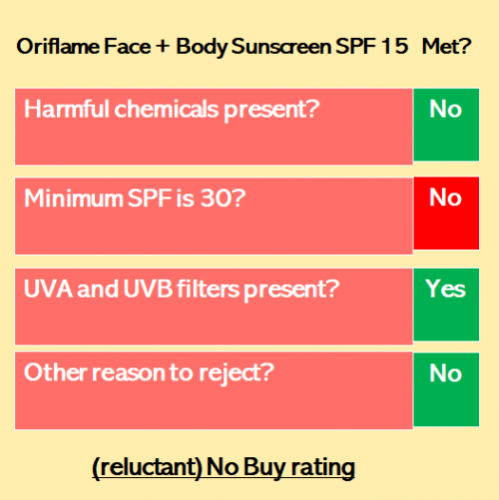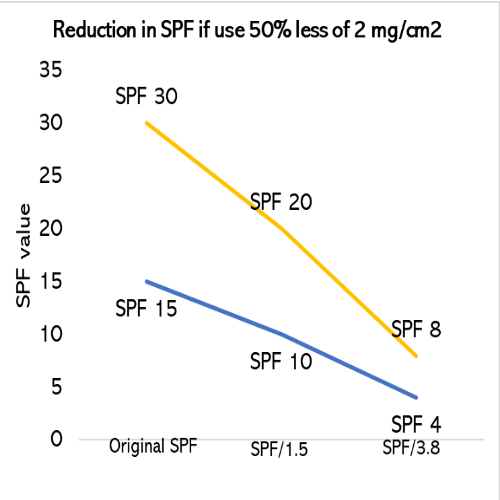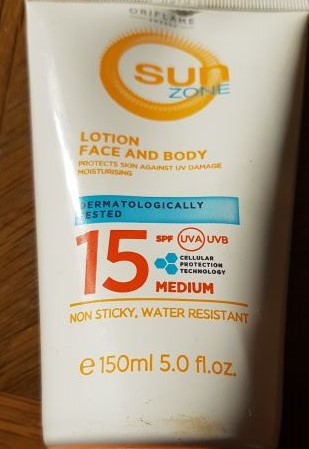Happy Skin Days Sunscreen test

My view: I am very reluctant to say goodbye to this product, but the SPF 15 is a deal breaker
2) Minimum SPF is too low
Sun Protection Factor (SPF) number, tells you how long it takes for your skin to burn (redness or erythema) with sunscreen compared to when no product is used at all.
Similarly, SPF tells you how much UV radiation – essentially, UVB – is blocked.
SPF 15 and SPF 30 block 93.3% and 96.7% respectively. It’s not a massive difference. Why then do I not like SPF 15?
The issue is our behaviour. The SPF only holds if you apply the correct amount of sunscreen: more precisely, exactly 2 mg/cm2
As its almost impossible to eyeball this amount, studies persistently show, people typically apply 0.5 to 1.5 mg/cm2 of sunscreen in real life instead of the above dosage.
Is applying LESS sunscreen really such a big deal?
It kind of is. When the dose is halved, the SPF value goes down by between 1.5 – 3.8.

SPF 15 very quickly becomes something between SPF 4 and SPF 10…
Coupled with the fact that UVR damage is cumulative – photoaging is not reversible and that (e.g.) New Delhi and most cities in India have very intense UVR, Indians cannot afford to use either LESS product or the wrong product….
(see also SPF 50 better than SPF 15?)
Bye, bye
It is with a heavy heart that I finish this blog. Were this even an SPF 30 I would be the first one to use it. If you have any queries, drop me a line at email@happyskindays.com
For those of you more interested in the filters, a short note follow. The rest of you – ciao.
P.S. A TECHNICAL NOTE ON FILTERS
“Filters” protect against damage caused by UV radiation. UVA rays penetrate our skin deeper and cause breakdown of collagen in our skin. Collagen is what gives skin its structure and resilience. Therefore, UVA causes longer-term structural damage to our skin.
UVA filters protect against the damage caused by UVA radiation, which in a nutshell is photo-damage (wrinkles, hyper-pigmentation and loss of skin elasticity). UVB filters protect mainly against UVB radiation, namely reddening of the skin (erythema), sunburn and skin-cancer. UVB/UVA filters combine the function of UVA and UVB filters.
- UVB filters:
- Octocrylene (4th ingredient out of 20 ingredients or “4/20”)
- Ethylhexyl Salicylate (common name – Octisalate) (10/20)
- UVA filters:
- Butyl Methoxydibenzoylmethane (common name – Avobenzone) (8/20)
- Diethylamino hydroxybenzoyl hexyl Benzoate (DHHB) (9/20)
- Bis-ethylhexyloxyphenol methoxyphenyl triazine (common name – Bemotrizinol) (11/20)
This product has new style UVA filters – DHHB and Bemotrizinol – that are photostable and are pretty effective at low concentrations. Also, this product has Octocrylene to stabilise Avobenzone. Bravo Oriflame. Its just too low an SPF….
See also Top 5 Sunscreen Recommendations, Do You Know Your Filters?, Guide to Buying Sun Protection, Do You Understand The Gibberish on Sunscreen Labels?
Sources and uses: Michaela Brenner and Vincent J. Hearing The Protective Role of Melanin Against UV Damage in Human Skin Photochemistry and Photobiology, 2008, 84: 539–549, http://www.bad.org.uk/shared/get-file.ashx?id=3917&itemtype=document
